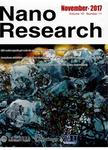An ultra-sensitive dual-mode imaging system using metal-enhanced fluorescence in solid phantoms
An ultra-sensitive dual-mode imaging system using metal-enhanced fluorescence in solid phantoms作者机构:Faculty of Engineering and the Institute of Nanotechnology and Advanced Materials Bar Ilan University Ramat Gan 5290002 Israel Center for Fluorescence Spectroscopy Department of Biochemistry and Molecular Biology University of Maryland School of Medicine Baltimore MD 21201 USA
出 版 物:《Nano Research》 (纳米研究(英文版))
年 卷 期:2015年第8卷第12期
页 面:3912-3921页
核心收录:
学科分类:081704[工学-应用化学] 07[理学] 08[工学] 0817[工学-化学工程与技术] 080203[工学-机械设计及理论] 070303[理学-有机化学] 0802[工学-机械工程] 0703[理学-化学]
基 金:supported by the U.S. National Institutes of Health
主 题:gold nanoparticles biomolecular imaging noninvasive detection diffusion reflection fluorescence lifetimeimaging metal-enhanced fluorescence
摘 要:In this study, we developed a highly sensitive dual-mode imaging system using gold nanoparticles (GNPs) conjugated to various fluorophores in solid phantoms. The system consists of fluorescence-lifetime imaging microscopy (FLIM) for surface imaging, diffusion reflection (DR) for deep-tissue imaging (up to 1 cm), and metal-enhanced fluorescence (MEF). We detected quenching in the fluorescent intensity (FI) for the conjugation of both gold nanospheres (GNS) and gold nanorods (GNRs) to Fluorescein, which has an excitation peak at a wavelength shorter than the surface plasmon resonance (SPR) of both types of GNPs. Enhanced FI was detected in conjugation to Rhodamine B (RhB) and Sulforhodamine B (SRB), both with excitation peaks in the SPR regions of the GNPs. The enhanced FI was detected both in solution and in solid phantoms by the FLIM measurements. DR measurements detected the presence of GNRs within the solid phantoms by recording the dropped rates of light scattering in wavelengths corresponding to the absorption spectra of the GNRs. With the inclusion of MEF, this promising dual-mode imaging technique enables efficient and sensitive molecular and functional imaging.



